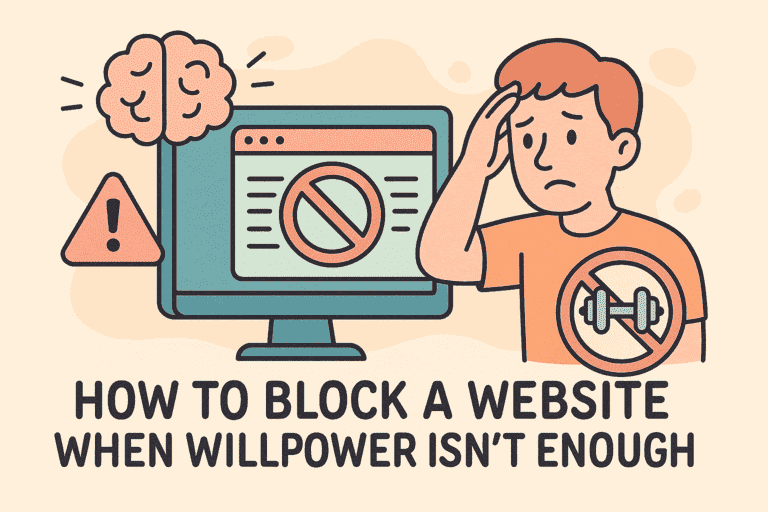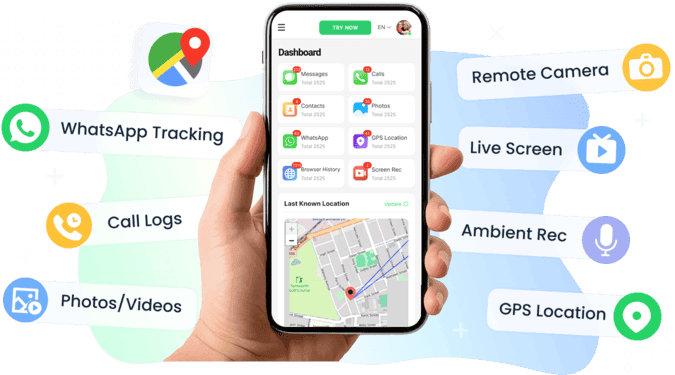Tried Cold Turkey and still found a way around it—like messing with your computer’s clock? Yeah, a lot of us have been there. Even the so-called “best” blockers aren’t bulletproof, and let’s be honest, self-control usually slips when the urge hits.
That’s why people mix different tricks: some go with quick browser add-ons, others lock things down at the router level, and a few use all-in-one apps like VigilKids that make it way harder to cheat.
- Table Of Contents
- Part 1.Why Blocking Software Alone Isn't Enough
- Part 2.Top Methods to Block a Website
PART 1. Why Blocking Software Alone Isn't Enough
A lot of people assume that finding the “best” website blocker will solve the problem once and for all. But the reality is harsher. One Reddit user shared how they were addicted to a game site: even after installing Cold Turkey—supposedly one of the strongest blockers—they quickly figured out a loophole by changing their device’s clock. Just like that, the site unlocked whenever they wanted, and the cycle of distraction kept going.

The comments under that post revealed a few important truths:
- Willpower alone won’t cut it. As one reply put it, even if you block a few sites completely, you’ll just end up on another one. The procrastination loop continues.
- Sites are built to be addictive. Another commenter reminded everyone that big tech companies pour millions into making platforms as captivating as possible. Expecting raw willpower to beat that is asking too much.
- Tech loopholes are everywhere. From disabling time changes to editing the hosts file or using router-level blocks, there’s almost always a way around.
The takeaway? Blockers aren’t a magic cure—they’re just tools. To really stop yourself from slipping, you need a layered strategy: combine technical barriers with better habits, change your study environment, and use small tricks (like boring breaks or box breathing) to ease the urge when it hits.
PART 2. Top Methods to Block a Website
There isn’t just one way to block a distracting site. Depending on how strict you need the block to be, you can go from quick browser add-ons all the way to system-level or even router-level restrictions. Let’s start with the simplest option.
2.1 Browser Extensions
Browser add-ons are the quickest way to stop yourself from opening distracting sites. They run directly inside your browser, so you don’t need to install heavy software or change system settings.
Popular options:
- StayFocusd (Chrome): Lets you set a daily limit on how much time you spend on certain sites. Once the time runs out, the page is blocked until the next day.
- LeechBlock (Firefox): Offers more flexible rules—you can block sites at certain times of day, after a set amount of visits, or for specific durations.
How it works:
- Step 1.Install the extension from the Chrome Web Store or Firefox Add-ons site.
- Step 2.Add the websites you want to block (e.g., game portals, social media).
- Step 3.Set a time limit or a fixed schedule for when access should be denied.
Pros: Light, fast, and beginner-friendly. Great for testing if website blocking helps you.
Cons: Easy to bypass—just switch to another browser or use incognito/private mode. They only cover one browser at a time, not your entire system.
2.2 Hosts File/System Restrictions
If you want a tougher block, you can do it at the system level. Editing your hosts file means the computer itself will refuse to load certain domains by redirecting them to a blank page. This method applies across all browsers, so you can’t just switch to Chrome or Edge to sneak around it.
Extra step: To make it even harder to bypass, create a non-admin account for everyday use. Without admin rights, you can’t easily change the system clock, uninstall software, or edit the hosts file again. Some Reddit users recommend having a trusted friend set the admin password so you don’t know it.
Pros: Stronger than browser extensions, works system-wide, and blocks sites regardless of which browser you open.
Cons: The setup process can be tricky if you’re not comfortable editing system files. Mistakes in the hosts file can cause other websites or apps to stop working until it’s fixed.
2.3 Router-Level Blocking
Blocking at the router level cuts off access for every device on your network. You can log into your router’s settings, add the site to the block list, and save the changes.
Extra step: hand the admin password to a friend or write it down and store it somewhere inconvenient.
Pros: Full control—phones, tablets, and PCs on your Wi-Fi are all blocked.
Cons: Setup can be confusing if you’re not familiar with router settings.
2.4 Focus & Productivity Apps
Apps like Cold Turkey, Freedom, and FocusMe are popular for a reason. They can block sites, lock apps, and schedule “focus sessions” across multiple devices. Cold Turkey even has a setting to prevent you from changing the system clock, which is where many people slip.
Pros: Powerful, cross-platform, flexible scheduling.
Cons: Some users still find ways to cheat if they’re determined.
2.5 VigilKids (Recommended)
While most tools focus on blocking alone, VigilKids takes a broader approach. It’s designed not just to stop you from opening distracting sites, but also to help you build healthier digital habits over time. That makes it useful for students, professionals, and even parents who want to guide their kids’ screen use.

How it works:
- Step 1. Install VigilKids on your device. Install VigilKids
- Step 2. Add the apps or websites you want to block.
- Step 3. Set up study or work schedules so the block turns on automatically during key hours.
- Step 4. Check usage reports to see exactly where your time is going.
- Step 5. (Optional) Enable parental mode if you’re setting it up for a child, with alerts and monitoring included.
Key features:
- One-tap blocking of distracting sites and apps.
- Automatic focus sessions based on schedules you define.
- Detailed usage insights that highlight patterns and time drains.
- Parental control options for families, including safe browsing and app limits.
Pros: Combines website blocking with habit tracking and parental controls. More difficult to bypass than browser add-ons or simple apps.
Cons: Requires installation on your devices; full features are best when paired with ongoing use rather than one-time blocks.
Why it’s different: VigilKids isn’t just about cutting off access—it helps you understand and reshape your digital behavior. If you’ve struggled with cheating other blockers, this all-in-one system is better suited for long-term focus and accountability.
2.6 Psychological & Habit Tricks
No tool will completely fix the problem if the underlying habits don’t change. Many people find it easier to focus when they adjust their environment and routines alongside using blockers.
Practical tips:
-
Separate work and play spaces: If you always study at your desk and play games on the couch (or vice versa), your brain starts linking each place with that activity. This makes it easier to stay in “study mode” without constant temptation.
-
Take low-stimulation breaks: Instead of jumping to another screen, try standing up, stretching, or practicing simple breathing exercises. Even staring at a blank wall for five minutes can reset your focus better than scrolling.
-
Start with small wins: Don’t aim for a three-hour focus block right away. Begin with 10–15 minutes of uninterrupted work, then increase the time gradually. This builds confidence and trains your attention span.
-
Use boredom to your advantage: If the only alternative to work is doing nothing particularly fun, you’ll often choose to get the task done rather than sit in discomfort.
Pros: Builds long-term habits that stick, works alongside any technical method.
Cons: Requires patience and consistency—you won’t see instant results.
Why it matters: Website blockers can give you a head start, but lasting change comes from shifting how your brain associates work, rest, and reward. Combining tools like VigilKids with these habit tricks creates the strongest defense against digital distractions.
Conclusion
Blocking a website isn’t about punishing yourself—it’s about creating the right conditions to focus. Simple tools like browser extensions work for light distractions, while system or router-level blocks are harder to bypass if you need stronger control. Productivity apps add scheduling and cross-device features, but if you want a complete solution that combines blocking with habit-building, VigilKids is the smarter choice.
At the end of the day, no single method is perfect. Pairing the right tool with small habit changes—like setting clear work spaces and taking low-stimulation breaks—gives you the best chance to stay on track.
